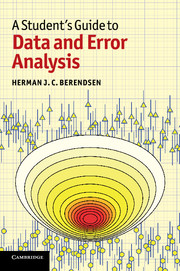Book contents
- Frontmatter
- Contents
- Preface
- Part I Data and error analysis
- 1 Introduction
- 2 The presentation of physical quantities with their inaccuracies
- 3 Errors: classification and propagation
- 4 Probability distributions
- 5 Processing of experimental data
- 6 Graphical handling of data with errors
- 7 Fitting functions to data
- 8 Back to Bayes: knowledge as a probability distribution
- References
- Answers to exercises
- Part II Appendices
- Part III Python codes
- Part IV Scientific data
- Index
2 - The presentation of physical quantities with their inaccuracies
Published online by Cambridge University Press: 05 June 2012
- Frontmatter
- Contents
- Preface
- Part I Data and error analysis
- 1 Introduction
- 2 The presentation of physical quantities with their inaccuracies
- 3 Errors: classification and propagation
- 4 Probability distributions
- 5 Processing of experimental data
- 6 Graphical handling of data with errors
- 7 Fitting functions to data
- 8 Back to Bayes: knowledge as a probability distribution
- References
- Answers to exercises
- Part II Appendices
- Part III Python codes
- Part IV Scientific data
- Index
Summary
This chapter is about the presentation of experimental results. When the value of a physical quantity is reported, the uncertainty in the value must be properly reported too, and it must be clear to the reader what kind of uncertainty is meant and how it has been estimated. Given the uncertainty, the value must be reported with the proper number of digits. But the quantity also has a unit that must be reported according to international standards. Thus this chapter is about reporting your results: this is the last thing you do, but we'll make it the first chapter before more serious matters require attention.
How to report a series of measurements
In most cases you derive a result on the basis of a series of (similar) measurements. In general you do not report all individual outcomes of the measurements, but you report the best estimates of the quantity you wish to “measure,” based on the experimental data and on the model you use to derive the required quantity from the data. In fact, you use a data reduction method. In a publication you are required to be explicit about the method used to derive the end result from the data. However, in certain cases you may also choose to report details of the data themselves (preferably in an appendix or deposited as “additional material”); this enables the reader to check your results or apply alternative data reduction methods.
- Type
- Chapter
- Information
- A Student's Guide to Data and Error Analysis , pp. 5 - 17Publisher: Cambridge University PressPrint publication year: 2011



